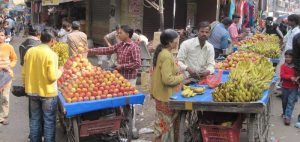Today Current Affairs: 2nd November 2021 for UPSC IAS exams, State PSC exams, SSC CGL, State SSC, RRB, Railways, Banking Exam & IBPS, etc
Table of Contents
Informal Sector:

Signalling a greater shift towards formalisation of the economy, the share of the large informal sector in overall economic activity dipped sharply in 2020-21 even as informal workers continue to bear the brunt of the pandemic’s adverse effects, the SBI said in a research report.
- The share of the informal economy may have shrunk to no more than 20% of the economic output from about 52% in 2017-18.
- There are wide variations in the formalisation levels in different sectors but the SBI estimated that the informal economy is possibly at a maximum of 15% to 20% of formal GDP in 2020-21.
- The SBI projections suggest that the informal agriculture sector has shrunk from 97.1% of the sector’s GVA in 2017-18 to just 70%-75% in 2020-21, driven by the increased penetration of credit through Kisan credit cards. Real estate has also seen a significant dip in informal activity from 52.8% in 2017-18 to 20%-25% last year.
- The report estimated that about ₹1.2 lakh crore of cash usage has been formalised since the COVID-19 pandemic.
- Formal agriculture credit flows have grown ₹4.6 lakh crore between 2017-18 and 2020-21, with digital payments for petrol and diesel rising around ₹1 lakh crore in the same period.
- The informal sector consists of “own-account” or unorganised enterprises employing hired workers, with the highest share of such unorganised activity being in agriculture where holdings are small and fragmented.
- As per a National Sample Survey (NSS) of 2014, around 93% of the workforce earned their livelihoods as informal workers.
- An IMF policy paper earlier this year estimated that the share of India’s informal economy in the Gross Value Added (GVA) was at 53.9% in 2011-12 and improved only marginally to 52.4% in 2017-18.
Indus River Dolphin:

The census of one of the world’s most threatened cetaceans, the Indus river dolphin (Platanista gangetica minor) — a freshwater dolphin that is found in river Beas, is all set to commence in the winter as part of a project by the Centre.
- However, Punjab’s wildlife preservation wing has gone a step ahead to not only protect the dolphins but also their natural habitat.
- The Indus river dolphin is classified as endangered by the International Union for the Conservation of Nature (IUCN) and, until recently, it was believed that these dolphins were endemic to Pakistan.
- But in 2007, a remnant but viable population of Indus dolphins was discovered in Punjab’s Harike wildlife sanctuary and in the lower Beas river.
- Since its discovery, research is being done by Punjab’s Department of Forests and Wildlife Preservation in partnership with WWF-India on the current distribution, habitat use and population abundance of the mammal.
- The Indus river dolphin was declared the State aquatic animal of Punjab in 2019.
- Extension programmes will be held in Punjab to develop a group of dedicated individuals, called ‘Beas-Dolphin Mitras’ [friends and protectors] of the river Beas.
G-20 Summit:

India pushed for “safeguarding the interests of the developing world” as Prime Minister Narendra Modi addressed the G-20 summit at sessions on climate change and sustainable development, said G-20 Sherpa and Commerce Minister Piyush Goyal.
- No time-bound agreements were reached as leaders of the world’s top economies ended the summit in Rome, recommitting to providing $100 billion a year to counter climate change, and pushing for greater vaccine equality to fight the COVID-19 pandemic.
- G-20 countries also committed to ending international financing for all new coal plants by the end of 2021, but made no mention of domestic commitments on ending coal power generation.
- The final communique, agreed upon after negotiations overnight, spoke only of the “key relevance of achieving global net zero” on carbon emissions “by or around mid-century”.
- Amongst the other highlights of the statement was a decision to pursue the recognition of more vaccines by the World Health Organization under a “One Health approach” for the world, and providing finances and technology for vaccine production at “mRNA Hubs” in South Africa, Brazil and Argentina, and to mobilise more international public private financing for “green” projects.
- UN Secretary General Antonio Guterres said the failure of the G-20 summit to set a specific date for countries to achieve “Net Zero” carbon emissions had left his hopes “unfulfilled” but “not buried”, as the joint communique set the stage for tough negotiations at the COP26 Climate Change summit in Glasgow that begins on Monday.
- The 2021 G20 Rome summit was the sixteenth meeting of Group of Twenty (G20), that took place in Rome, the capital city of Italy, on 30–31 October 2021.
World Pedestrian Day:

In a meeting with state transport minister, Amarinder Raja Warring, recently on Road Safety, Punjab Police’s ADGP (traffic), Dr Sharad Satya Chauhan, proposed that the birth anniversary (Gurpurab) of Sikhism founder Guru Nanak Dev be declared as ‘World Pedestrian Day’.
- A written proposal in this regard may be sent to the Union Ministry of Road Transport and Highways soon.
- To spread the message of oneness and to break barriers across faiths by engaging in spiritual dialogues, the founder of Sikhism, Guru Nanak Dev, travelled far and wide during the 15th and 16th centuries.
- From Mecca to Haridwar, from Sylhet to Mount Kailash, Guru Nanak visited hundreds of interfaith sites related to Hinduism, Islam, Buddhism, and Jainism throughout his journeys (also called udaasis).
- At some sites, gurdwaras were constructed to commemorate his visit.
- Later his travels were documented in texts called ‘janamsakhis’. These sites are now spread across nine nations as per current geographical divisions — India, Pakistan, Iran, Iraq, China (Tibet), Bangladesh, Saudi Arabia, Sri Lanka, and Afghanistan — and some are even inaccessible due to travel restrictions or being located in conflict zones.
- It is believed that during those times, when early modes of transport were limited and were mostly restricted to boats, animals (horses, mules, camels, bullock carts), Guru Nanak Dev, along with his companion Bhai Mardana, undertook most part of his journeys on foot.
Y 12704 (Visakhapatnam):

Y 12704 (Visakhapatnam), the lead ship of Project 15B stealth guided missile destroyers being built at Mazgaon Docks Limited (MDL), was delivered to the Indian Navy on 28 October 2021.
- The contract for four ships of Project 15B, as the Visakhapatnam class ships are known, was signed on 28 January 2011. This project is a follow-on of the Kolkata class (Project 15A) destroyers commissioned in the last decade.
- Designed by Directorate of Naval Design, Indian Navy’s in-house design organisation; and built by M/s Mazagon Dock Shipbuilders Ltd, Mumbai; the four ships are christened after major cities from all four corners of the country viz. Visakhapatnam, Mormugao, Imphal and Surat.
- The keel of Visakhapatnam was laid in October 2013 and the ship was launched in April 2015.
- The 163 metres long warship has a full load displacement of 7400 tonnes and maximum speed of 30 knots. The overall indigenous content of the project is approx. 75%.
The destroyer is installed with major indigenous weapons which include:
- Medium Range Surface-to-Air Missiles (BEL, Bangalore).
- BrahMos Surface-to-Surface Missiles (BrahMos Aerospace, New Delhi).
- Indigenous Torpedo Tube Launchers (Larsen & Toubro, Mumbai).
- Anti-Submarine Indigenous Rocket Launchers (Larsen & Toubro, Mumbai).
- 76mm Super Rapid Gun Mount (BHEL, Haridwar).
Dairy Sahakar Scheme:

Shri Amit Shah, Union Minister of Home Affairs and Cooporation launched the “Dairy Sahakar” scheme at Anand, Gujarat, during the function organised by Amul for celebration of 75th Foundation Year of Amul.
- The Dairy Sahakar with a total investment of Rs 5000 crore will be implemented by NCDC under Ministry of Cooperation, Government of India to realize the vision, “from cooperation to prosperity”.
- Under it, financial support will be extended by NCDC to eligible cooperatives for activities such as bovine development, milk procurement, processing, quality assurance, value addition, branding, packaging, marketing, transportation and storage of milk and milk products, exports of dairy products within the overall objectives of “Doubling the farmers income”.
- There will also be a convergence with various schemes of Government of India and / or of State Government/UT Administration/ Development agencies/ bilateral/multilateral assistance/ CSR mechanism is encouraged.
- The Department of Animal Husbandry and Dairying under Ministry of Fisheries, Animal Husbandry and Dairying, Government of India is also implementing various schemes for development of the Animal Husbandry and dairy sector.
- This Dairy Sahakar will supplement the existing efforts for strengthening the dairy sector in the country.




